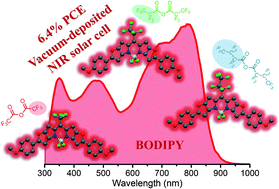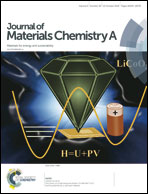Boron dipyrromethene (BODIPY) with meso-perfluorinated alkyl substituents as near infrared donors in organic solar cells†
Abstract
Three furan-fused BODIPYs were synthesized with perfluorinated methyl, ethyl and n-propyl groups on the meso-carbon. They were obtained with high yields by reacting the furan-fused 2-carboxylpyrrole in corresponding perfluorinated acid and anhydride. With the increase in perfluorinated alkyl chain length, the molecular packing in the single crystal is influenced, showing increasing stacking distance and decreasing slope angle. All the BODIPYs were characterized as intense absorbers in near infrared region in solid state, peaking at ∼800 nm with absorption coefficient of over 280 000 cm−1. Facilitated by high thermal stability, the furan-fused BODIPYs were employed in vacuum-deposited organic solar cells as electron donors. All devices exhibit PCE over 6.0% with the EQE maximum reaching 70% at ∼790 nm. The chemical modification of the BODIPY donors have certain influence on the active layer morphology, and the highest PCE of 6.4% was obtained with a notably high jsc of 13.6 mA cm−2. Sensitive EQE and electroluminance studies indicated that the energy losses generated by the formation of a charge transfer state and the radiative recombination at the donor–acceptor interface were comparable in the range of 0.14–0.19 V, while non-radiative recombination energy loss of 0.38 V was the main energy loss route resulting in the moderate Voc of 0.76 V.



 Please wait while we load your content...
Please wait while we load your content...